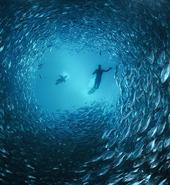..It's a bizarre fact, but we know more about outer space than we do about our oceans. Well, this landmark series tries to address the balance, as the Daddy of nature programmes, David Attenborough, reminds us that "Over 70% of it is covered by the sea and the Pacific Ocean alone covers half the globe".
The oceans dominate the world's weather systems and support an enormous variety of life, from the largest animal that has ever lived on Earth, the blue whale - 30 metres long and weighing over 200 tonnes - to the tiniest piece of plankton.
The deep
It's also mad to think that 60% of the Earth's surface is covered by ocean more than a mile deep. The reason we know so little about these vast dark depths is that only a handful of submarines are capable of diving that deep. And when we do get to see what lurks there, it's like something out of Star Wars. Some of these animals have never been filmed before, such as the Hairy Angler, which is the size of a beach ball. Its body is covered in long antennae designed to pick out the movements of any fool fish who ventures close to its terrifying teeth.
Open oceans
Ready for another mad fact? Thought so. The open ocean covers more than 360 million square kms of the Earth's surface, but much of it is a marine desert with virtually no sign of life; yet somehow the fastest and most powerful predators in the world survive thousands of miles out to sea.
Frozen seas
For most of the year, both the North and South poles are dark and bitterly cold, but there is life at both ends of the Earth. Antarctica is a continent, a landmass in its own right surrounded by ice, where Emperor penguins sit out the winter in temperatures below -50 degrees Celsius. The Arctic on the other hand, is a frozen sea surrounded by land, and here the polar bear rules with an iron claw - no seal, whale or bird is safe.
Layout Created at KillerKiwi.net
